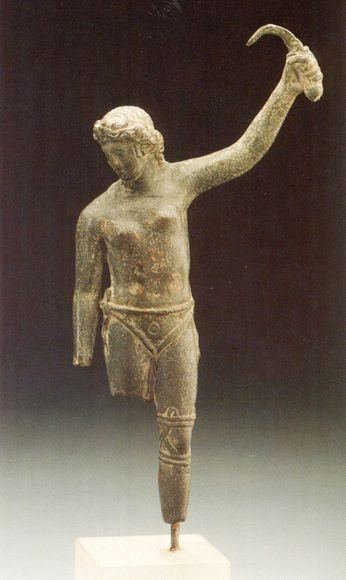Rare Topless Statue Confirms Existence of Female Gladiators in Ancient Rome

A rare bronze statue holding a short sword and currently housed in the Museum für Kunst und Gewerbein Hamburg, Germany, could be the only second depiction of a woman gladiator known to exist, a new study by Alfonso Manas from Spain's University of Granada says.
The findings reported in the recent edition of the journal of the International Journal of the History of Sport suggest that the statue dates back nearly 2000 years. Contrary to popular notion that women were banned from gladiatorial matches during AD200, the study confirms that even women were forced to fight in Roman arenas.
The statue in the Hambug museum features a bare-chested woman dressed in a loincloth with a short, curved sword in her hand. Alfonso says that the sword resembles a sica which was typically used by gladiators while combating in the arenas. He says in his report that the gesture of the statue resembles a form of "salute to the people, to the crowd", an action usually done by victorious gladiators at the end of a fight.
LiveScience reported that the rarity of such statues likely reflects the idea that female gladiators in ancient Rome were scarce. They were banned by Emperor Septimius Severus in AD 200 with only about a dozen references to them in ancient writing surviving to present day.
According to UPI, prior to this, the only other depiction of a female gladiator was in a relief from Halicarnassus, which is now housed in the British Museum.
Apart from this, in July 2010, the BBC reported that archaeologists engaged in a rescue dig at Credenhill Herefordshire had uncovered the remains of what might have been a female gladiator.
The burial, which was in a wooden chest secured with three iron bands and a number of iron nails, was in a crouched position. Such a coffin indicated the dead person's status. When removed, the leg and arm bones were found to be unusually heavy with large attachment points for what were clearly strong muscles.
Additionally, the National Geographic reported that in the past, there were eyewitness accounts of female gladiators in Rome itself. In fact, according to the first-century historian Suetonius, Emperor Domitian made women fight by torchlight at night.
© Copyright IBTimes 2025. All rights reserved.



















